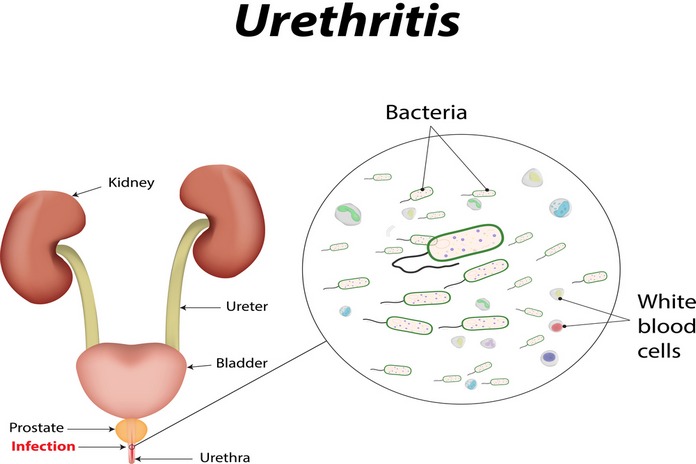Urethritis
Urethritis is an inflammation and irritation of the urethra, which carries urine from the bladder to the outside of the body. The male urethra also transports sperm. An increased urge to urinate and pain while urinating are typical symptoms of urethritis. Usually, urethritis is caused by bacterial infection.
There is a difference between urethritis and urinary tract infections (UTI). A UTI, as its name suggests, is an infection of the urinary tract while urethritis is an inflammation of the urethra. The symptoms of urethritis may be similar, but different treatments are needed depending on the underlying condition. (1)
Every age group is affected by urethritis. Women and men can both suffer from it. A higher proportion of females than males are at risk for the condition. Partly because men have longer urethras, which make up the length of the penis, than women. It is normal for a woman’s urethra to be one and a half inches long. Bacteria find it easier to enter the urethra because of this length.
The cause of urethritis is usually a virus or bacteria. It can also be triggered by a chemical irritant. The condition differs from a urinary tract infection (UTI), which mostly affects the entire urinary tract. Sexual contact without protection can transmit the disease. The female partner can catch a vaginal infection from the female partner.

Urethritis is characterized by painful urination. The most common underlying cause of urethritis is infection by bacteria contracted through sexual contact. Antibiotics are typically used to treat it.
Though urethritis may have infectious or noninfectious origins, it is usually referred to as an inflammation of the urethra due to a sexually transmitted disease (STD).
Infectious urethritis can be caused by several organisms. The condition is usually classified as either gonococcal urethritis (GU), due to the gram-negative intracellular diplococci Neisseria gonorrhoeae, or nongonococcal urethritis (NGU). (2)
- This condition may be caused by sexually transmitted diseases (STDs) or by a bacterial infection of the urinary tract (also known as a bladder infection), both of which can lead to similar symptoms.
- The risk of developing infectious urethritis is highest in men between the ages of 20-35, men who have more than one sexual partner or engage in high-risk behavior, such as anal intercourse or not using condoms.
- A common symptom of urethritis is burning and pain.
- The long-term effects may result in infertility or urethral blockages (strictures).
Nongonococcal Urethritis in Men
In most cases, nongonococcal urethritis is spread through sex. Typically, men suffer from the condition. Symptoms include burning while urinating and penis discharge. To treat nongonococcal urethritis, healthcare providers use antibiotics. Remember to take your medicine as prescribed. You should also tell your sexual partner(s) for their support.
What Is Nongonococcal Urethritis?
Nongonococcal urethritis (NGU) occurs when the urethra is irritated or inflamed. Urine (pee) leaves the body from the bladder through the urethra, which is a small tube found in the penis.
Men are more likely to suffer from this type of inflammation. A typical cause is an infection or a germ entering the body. An infected partner is the source of this sexually transmitted infection (STI).
- Acute urethral discharge is a classic symptom of urethritis after unprotected sex.
- Neisseria gonorrhoeae and Chlamydia trachomatis are the two main etiologic agents.
- There is an increased risk when you have a new partner, have multiple partners, or if you are under 25 years old. It is possible for infected mothers to transmit the disease to their infants, resulting in otitis media, iritis, pneumonia, or conjunctivitis.
- Female morbidity is higher (10% to 40%) compared to male morbidity (1% to 2%).
- In the case of untreated gonococcal urethritis, meningitis, arthritis, and endocarditis may develop. When left untreated, nongonococcal urethritis can lead to infertility or reactive arthritis.

